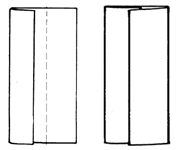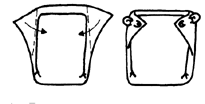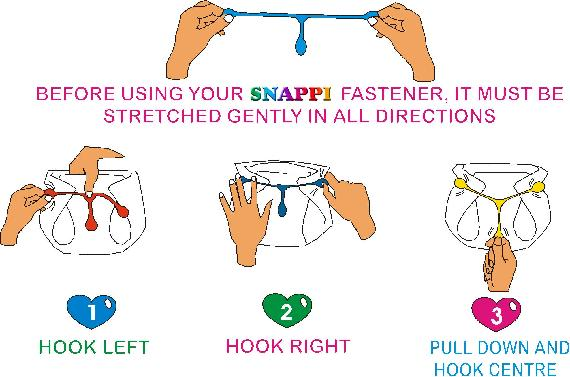We have affordable cloth diapers and accessories in stock and ready to be shipped. All products sold have been personally tried and tested on our own babies and are given our personal seal of approval (We have tried MANY different types and brands of cloth diapers, wraps/covers, and accessories) and these are the very BEST!
Today there are many options available for cloth diapering however, none of them offer the economy and trustworthiness of traditional birdseye, prefolded or flat, white, diapers. folded, pinned, then covered with plastic or rubber pants. You just can't do better than that. Even larger older babies can be best accommodated with these same traditional products. After all, why not use the same solutions
Birdseye cloth diapers are the old-fashioned version of a one size cloth diaper. Your grandma or great-grandma probably used these soft cotton diapers for their babies. These deceptively simple pieces of cloth are perfect for keeping a baby dry.
Birdseye cloth diapers are simple to use and they are one of the cheapest cloth diapering options One reason they are such a great deal for diapering your baby is that they can easily be recycled several times after baby is through with diapers. A small investment could get you enough cloth diapers and diaper covers to last until your baby potty-trains, then you can use them as cleaning cloths!
Birdseye cloth diapers are made from a single layer of cotton fabric known as birdseye. The name comes from the diamond texture of the fabric weave. Birdseye is very absorbent and becomes softer with use.
The very low start-up cost of using birdseye diapers is not the only way these old-fashioned diapers save you money. Birdseye cloth diapers save you money on electricity as well since they are so easy to clean and dry. They wash and dry quickly yet are still very absorbent. They are a great choice if you want to line-dry your diapers, are on a very tight budget, or want to use them while traveling.
Because these diapers dry so quickly they are great for line drying. You can easily wash them for camping and travel, making them a great choice for any situation where you do not have access to washing and drying facilities or when you want to save energy on washing and drying.
Birdseye is a low-lint fabric, making it perfect for cleaning windows and dusting. Many people buy birdseye cloth diapers for use as cleaning cloths. They are the gold standard for polishing cars and cleaning the interior. Flat diapers are also great for lap pads, burp cloths, dish towels and other uses.
Folding flat diapers does take a little learning, but it is an art-from you'll master in no time. Soon you'll be diapering your baby with ease.
Flat Diapers:
- Flat diapers come in two shapes: rectangle and square. At this point it comes to personal preference. The flat diaper are good for double diapering but flat diapers are almost impossible to find. Some mothers like the rectangle so they can fold them to fit best on the shape of their baby's bottom.
- There are two fabrics that have been used for diapers: light gauze and traditional birdseye. Gauze used to be the cheapest, and lightest fabric but we find that the light gauze doesn't hold up well as traditional birdseye.
- Flat diapers have the benefit that they are the fastest drying diaper. This could be a consideration if you line dry in a humid climate.
Prefold Diapers:
- These are the easiest to use of all diapers. They are sewn into a rectangle that can be folded into many different shapes to fit babies of all ages.
- Prefold diapers come layered with the center panel thicker than the sides (sometimes called 4 to 8 layer) and are more absorbent. Avoid the ones that are lined with a foam core, as they tend to self destruct faster and provide a haven for odor producing bacteria.
Size:
- New born or preemie: You will need at least one dozen for the first month or so if you have a early baby, or if small butts run in your family, but most mommies just fold a standard diaper down to a smaller size.
- Standard: Fine for most babies.
You will probably find yourself doubling them as you
get in the toddler years.
- Toddler diapers: Far too often babies
are pushed to potty train. This isn't a road race.
Slow down and cherish those diaper bottoms. We have
diapers for every size.
- Bigger Baby Diapers We carry a full line of cloth diapers that will even fit babies over 200 pounds.
Babies in the Elizabethan era often went 4 days without a diaper change. Your baby will wet from 8-12 diapers a day. Some babies trickle a little all of the time, and need to be changed more often. Other babies wait for a long time and then flood. If your baby wets less than 4 times a day, you may want to ask your doctor about dehydration. A younger baby will use less diapers than an older baby. We recommend 2 to 4 dozen diapers to start with. You will want more if you don't have a washer. If you have been using disposables, you may find that you use more diapers than before. There is a different rhythm to changing. With chemically enhanced disposables, you never really know when a baby has wet. Changing is determined by the clock. Be aware that even if there is no liquid in a disposable diaper, the urine is still in contact with the baby's bottom. With cotton diapers, you will be changing when it needs to be done. Watch an experienced mother that has used cotton diapers for a while. Every time she picks up her baby, her finger checks the top of the diaper for dampness, or she feels the bottom from the outside for that heavy, warm sensation. This becomes an unconscious move on her part. The toddler, as they near potty training time, becomes aware of when they pee and poop in a cotton diaper. It is mushy, damp, and heavy. They start to relate their physical action of elimination, with a change in their comfort level. This makes potty training easier. Disposables because they mask the damp feeling, make it more difficult to potty train. There is also some evidence that irritation from chemicals in the disposables cause mild bladder irritation adding to the difficulty of potty training.
When fitting cloth diapers you must remember that this isn't a style show, even though there is nothing more endearing than the sight of diapered baby bottoms paddling around the room. Our diapers will shrink 2 to 3 inches when washed. They quilt up and become softer and more absorbent during the first five to ten washings. Diapers should come up to just below the navel. A tight fitting and tightly pinned diaper has the advantage of containing any pooling until it can be absorbed by the diaper. It has the disadvantage that it can enable and aggravate a diaper rash problem. You will find yourself adjusting fit over time based on your babies response. Boy babies present the additional challenge of a flexible delivery hose. The most important aspects of a good diaper fit are getting it large enough and getting enough material in place. Our heavy weight diapers are as thick as some outlets call "night diapers" but we recommend one during the day and doubling at night.
Diaper Folding Technique My favorite diaper folding technique is the
angel wing or sometimes it's called the newspaper
fold. This fold works well with our pre folded
diapers. I like to do step one with all my diapers
as they are laundered and put in the changing
table drawer. Other techniques can work equally
well. This technique has a slight advantage in
containing baby poop in the diaper. The fold
forms a "pocket" in the back that can
help contain the contents within the diaper.
|
Today, we have lost much of the knowledge that mothers
of the 50's had about cloth diapering. This seems to
be especially prevalent among younger mothers. The only
purpose plastic pants have is to keep the babies clothing
dry. They can only be leak proof when properly used with
cloth diapers. Fitting plastic panties is certainly an
art. We recommend that plastic panties are fit large
giving a balloon effect. This isn't a style show but
the paramount requirement is that the babies bed or clothes
stay dry.  Panties
should be sized only with the fit around the waist and
legs as a consideration. The diaper should be fit to
reach to just below the navel and the plastic panty should
cover the navel. Notice how this baby is fit. For example
a large baby with a 34" waist would require size
large during the day with a single heavy weight diaper
and a size extra large at night when the baby is double
diapered. If you need help with your decision be sure
to contact us. During the
day diapers need to be changed every two hours but plastic
pants can be used for two or more diaper changes.Some
larger babies will find it embarrassing but be STRONGLY
recommend using baby clothes. Snap crotches will facilitate
fast easy diaper changes. With pinned diapers and snap
crotches pants, diapers can be changed by merely pulling
down the plastic pants rather than disrobing the baby.
Always use diaper powder. It's not just there to smell
nice, it plays an active part in preventing diaper rash.
Use ointment carefully around plastic pants. If you detect
a red rash mark dab it with Destine but clean the ointment
off your finger before touching the plastic pants. Destine
or any petroleum product will make plastic pants brittle
and crack when it get on them.
Panties
should be sized only with the fit around the waist and
legs as a consideration. The diaper should be fit to
reach to just below the navel and the plastic panty should
cover the navel. Notice how this baby is fit. For example
a large baby with a 34" waist would require size
large during the day with a single heavy weight diaper
and a size extra large at night when the baby is double
diapered. If you need help with your decision be sure
to contact us. During the
day diapers need to be changed every two hours but plastic
pants can be used for two or more diaper changes.Some
larger babies will find it embarrassing but be STRONGLY
recommend using baby clothes. Snap crotches will facilitate
fast easy diaper changes. With pinned diapers and snap
crotches pants, diapers can be changed by merely pulling
down the plastic pants rather than disrobing the baby.
Always use diaper powder. It's not just there to smell
nice, it plays an active part in preventing diaper rash.
Use ointment carefully around plastic pants. If you detect
a red rash mark dab it with Destine but clean the ointment
off your finger before touching the plastic pants. Destine
or any petroleum product will make plastic pants brittle
and crack when it get on them.
Laundry care for plastic pants depends on your washing machine. We don't recommend washing plastic pants in older machines where the agitator violently oscillates back and forth. If you must use an older machine change the cycle to gentle or delicate clothes. Because of the action in a newer HE (high efficiency) machine they can be used very effectively. For the longest panty life hand wash them. Never dry plastic pants in the sun or clothes dryer. Hang dry them. Generally they will dry overnight.
| DIRECTIONS
FOR USE: Snappi® fasteners must be used responsibly, and need to be used correctly in order to work effectively. 1. STRETCH the Snappi® fastener before its first use. The stretching triggers the 'memory' of the Snappi® to return to its original size, and in so doing, will pull the diaper together to the middle to allow for a snug fit. This is essential for the Snappi® to work properly. This can be done by holding the Snappi® in the center with one hand, and close to the end of the leg with the other hand. Then s-t-r-e-t-c-h a few times (10 or so). As you do this you should feel how the material 'softens' or gets more elastic. Follow this stretching procedure with each leg. The Snappi® is now ready to go! 2. Make sure that the Snappi® is ATTACHED SECURELY. It is important that the Snappi® 'leg' being attached be stretched across the diaper before hooking it into the diaper. When attaching the Snappi®, hold onto the solid part of the tab. DO NOT pull on the loops. So, Hook Left, Stretch ACROSS and Hook Right, Stretch DOWN and Hook Center In other words, the Snappi® fastener should go from a ‘T’ shape to a ‘Y’ shape. By following these instructions, the Snappi® should be secure and the diaper will fit snugly. ALWAYS place a cover over the diaper and Snappi® fastener. |
|
|
|
Washing Diapers is just not that big a deal. Scrape off what you can into the toilet, then throw them into the machine.
- Pails: Some people buy a special pail, others just keep the washer half full of water on a rinse cycle and run it when it gets full. Some keep a pail in the changing area, others keep it in the bathroom. Baking soda or vinegar will help with odor control. Do not use 5 gallon, industrial type buckets for a diaper pail, a small explorer can topple into them, head first.
- Soap: We prefer the use the cheapest biodegradable soap possible. Try for "soap" rather than "detergent," soap being gentler. Go to the local janitorial supply for a giant box of unscented biodegradable stuff that lasts a year for the family wash. Avoid fancy products that make things "Whiter than White." These contain Borates and can irritate your baby's bottom, and can damage many brands of diaper covers and elastic. (Most of the baby soaps contain borates, because we want baby things to be extra white.)
- The Machine: Use HOT water as much as possible. Usually double rinsing isn't necessary, but if you use whiteners, you must double rinse.
- Drying: We prefer to hang diapers. Sunlight is a natural germ killer, and everything smells so nice. It is also a nice time to be outside with your baby. But be realistic, when you have a family, you do not always have the luxury of time. You might want to line dry if there is a problem with diaper rash.
- A Couple of notes about Machine Drying: Clean the lint trap often; cotton diapers, especially when new, will tend to make more lint than most laundry. If you or your baby have asthma or allergies, do not use the softener sheets. If you have line dried the diapers, put them in to tumble for 2-3 minutes with a clean baby tennis shoe to fluff them.
- Folding: Some people do a folding marathon when the diapers come out of the drier, others are too busy (or perhaps lazy) and keep their diapers in a laundry basket, and fold as they use them.
Diaper Rash: Many people turn to cotton diapers because their baby has an on going diaper rash. Disposable diapers have chemicals that bind the moisture from the pee, but the irritants (natural acids in the pee) are still in contact with the little bottom, even if it doesn't feel wet to your hand. Diaper services use harsh chemicals. They have to because the diapers you get have been used by many other people, whose natural germs in their household are different than the natural germs in your house. So they have to be absolutely sterile. The best cure for diaper rash is prevention. Make sure that your baby is getting enough water. For nursed babies that means that the mother must be drinking lots of water and juices, especially in hot weather or when she is ill. Your baby should have at least 4 wet diapers a day, and their stool should not be hard and dry. Babies that are drinking from cups or bottles should always have liquids available. Water is the best for the other end as well. Rinse with water often. Soaps are usually not necessary as the stuff in a diaper is all water soluble, and soap can dry the skin. When you do use soap, rinse well. Keep a little wash cloth wet with water in a baggie in your diaper bag. (Those diaper wiper things are just water with perfume so you can be fooled into thinking that you are doing a better job than you are.) Just like the rest of your baby, the bottom will be healthier for a good dose of sun light and fresh air. Let your baby be with out diapers as much as possible. (This does not mean to leave your toddler out so they get sun burned.) Use every day products rather than commercial products that contain harsh and often toxic chemicals. Corn starch makes a wonderful powder, and contains no talc. Olive oil, almond oil, or cooking oil is as good as any baby oil, even better because it does not contain mineral oil which can deplete the skin of its natural moisture





